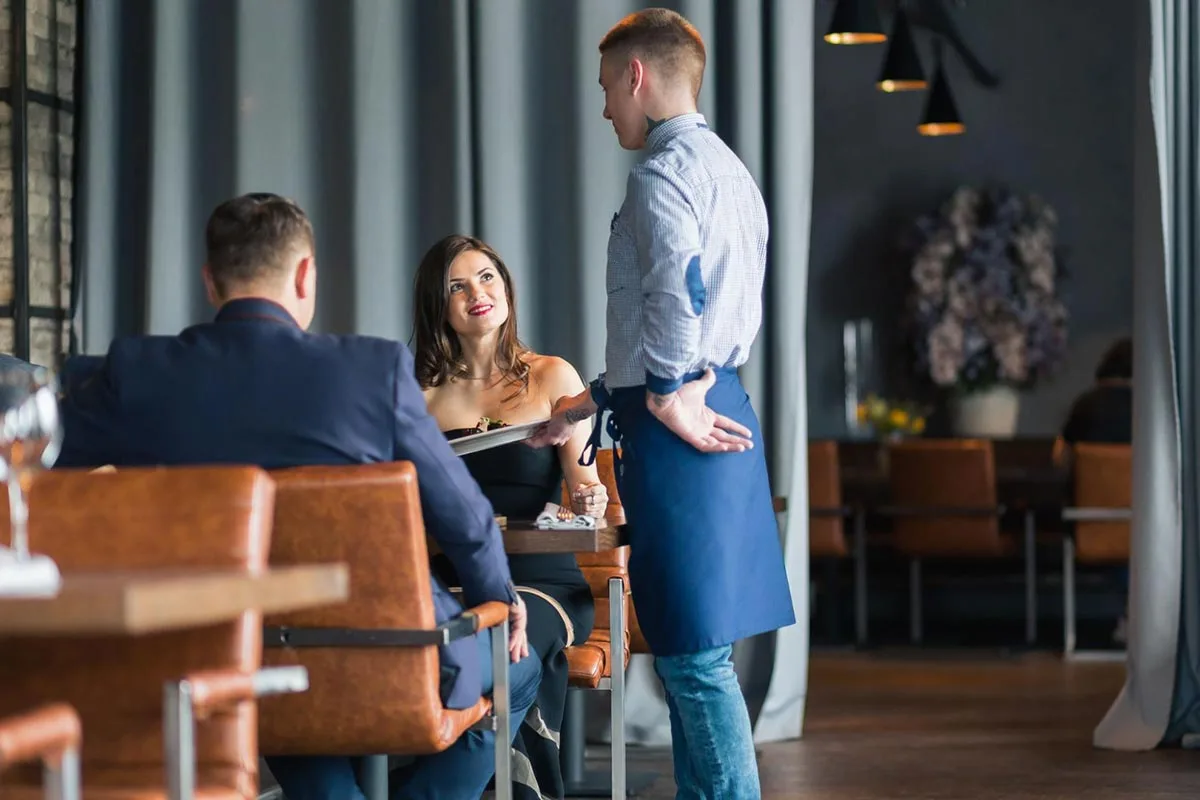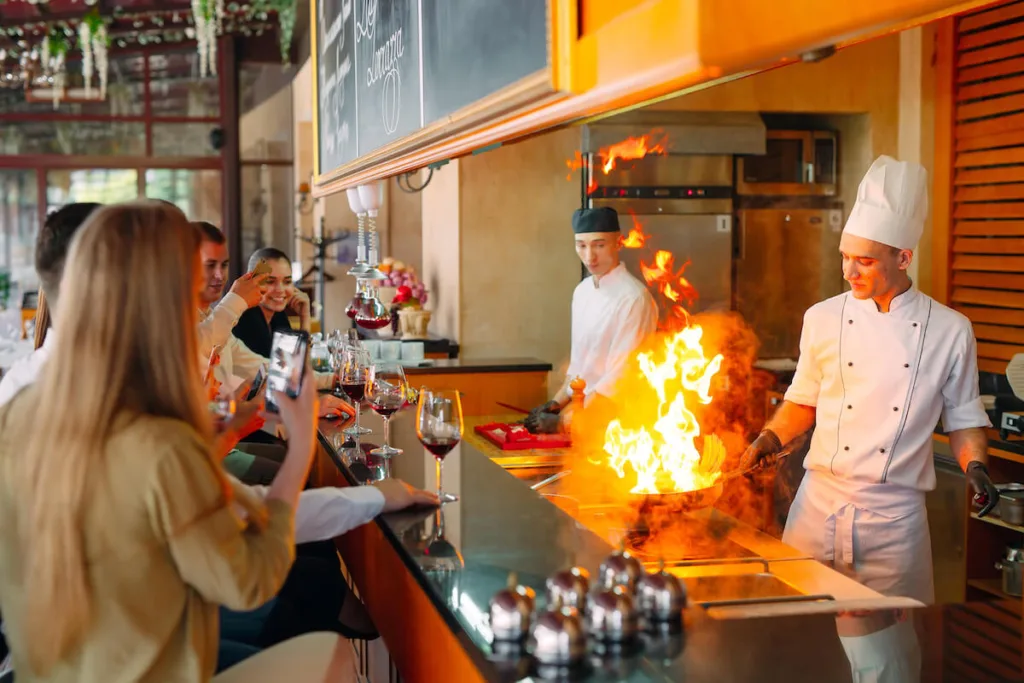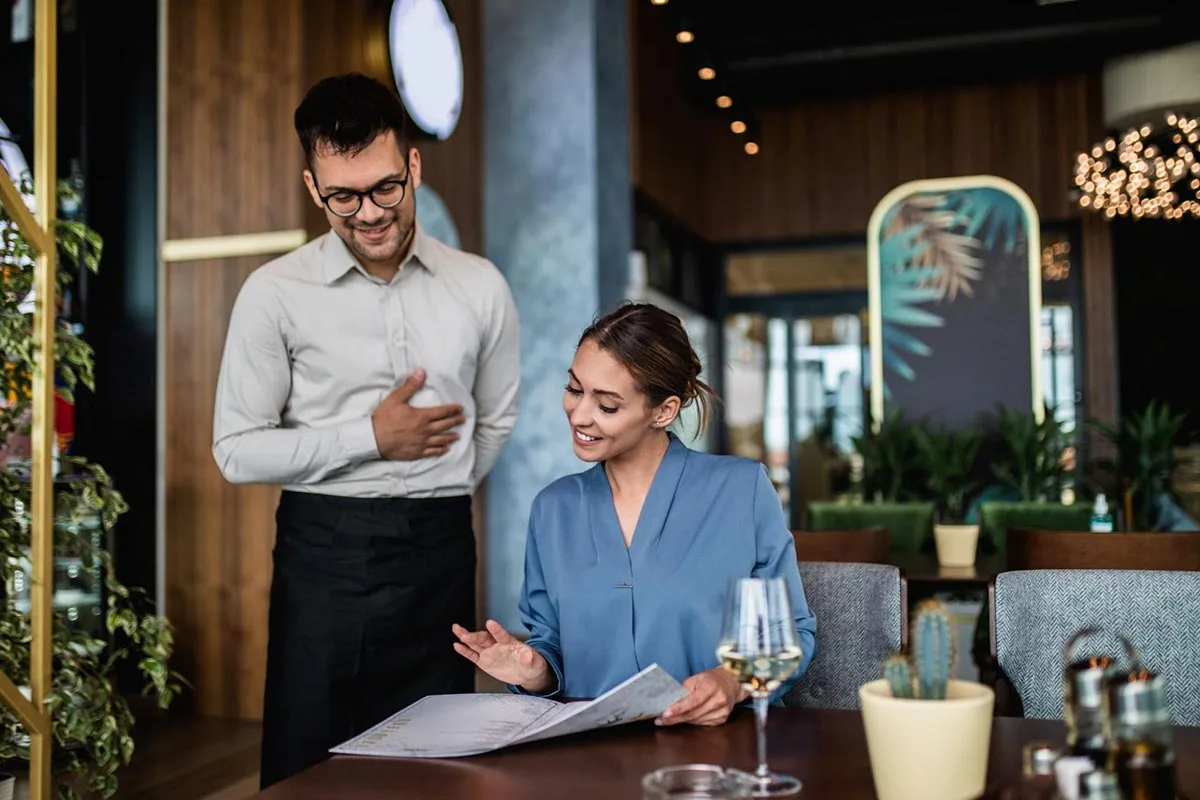7 steps to improve the guest experience in a restaurant
Skip the article and turn takeaways into action by scheduling a call with our team.
The guest experience is the heartbeat of any restaurant. In an era where dining options are endless, and reviews are just a click away, creating a memorable experience sets a restaurant apart from competitors. It’s not just about food—it’s about how guests feel from the moment they walk in to the moment they leave. “How to improve the guest experience in a restaurant” is a question restaurateurs have been asking forever, and it’s what we’ll examine today.
Loyal customers don’t just return—they become advocates of a restaurant. Since loyal customers are earned, restaurants can use the following seven strategies to optimize the guest experience. Let’s dive in.
1. Enhance staff training and engagement

Staff are the face of the restaurant. A warm greeting or a knowledgeable server can turn a good meal into a great one, while a rude or uninformed employee can ruin the night. The team’s attitude sets the tone for the guest experience. So, how do you train staff for maximum impact?
- Consider role-playing common scenarios staff will encounter, especially for servers—practice handling busy nights, upset guests, or accommodating special requests to build confidence and consistency.
- Teach empathy and active listening. Train staff to read body language, ask open-ended questions, maintain eye contact, and show genuine care. For example, if correcting a mistake, servers can ask, “How can I make this right for you?”
- Drill product knowledge. Every team member needs to know the menu inside and out, including ingredients, preparation methods, and allergen info, so they can confidently answer questions or suggest menu item pairings.
To keep staff members happy and engaged, offer incentives and recognition programs. For example, restaurant owners can provide bonuses for great online reviews or create an employee of the month program to keep morale high.
Creating a positive work environment goes a long way toward staff performance. Conduct regular check-ins, practice fair scheduling, and offer a supportive environment that fosters career growth to reduce turnover and keep staff interested in the restaurant’s success.
2. Personalize the dining experience
Adding a personal touch to the customer experience is a good way to keep repeat customers coming back. What are some good ways to create a personalized experience?
First, using front-of-house (FOH) software that stores guest data and remembers purchases, preferences, and important dates gives servers a leg up in making a positive experience for loyal customers. Servers can be notified of birthdays, anniversaries, and favorite dishes in FOH management systems like Yelp Guest Manager. This helps tailor the visit to the specific person.
Second, staff should be encouraged to notice and adapt to cues. For example, if a guest seems rushed, speed up service, or if they’re lingering, offer a relaxed pace. After enough experience, this will be subsumed into intuition.
Third, make a point to recall regular customers’ names and dietary preferences. A simple greeting with a customer’s name goes a long way in building rapport, as does recalling their favorite drink.
Fourth, opt for digital surveys and direct customer feedback. A good way to do this is to place QR codes on tables that lead to voluntary guest surveys so you can collect their opinions in real time—and act on good suggestions.
Fifth, create a loyalty program with valuable rewards. Of course, you can do this the old-fashioned way with punch cards, but loyalty programs have come a long way. Restaurants can now have a custom app built without breaking the bank, and some apps even come with AI-powered customer outreach.
3. Optimize service efficiency

Efficiency in restaurant operations goes a long way to drive customer satisfaction. It goes both ways: The more friction a restaurant reduces in its service, the more customers can be served.
Start in the kitchen. Kitchen coordination and timing straddle the line between science and art, and a well-polished team in the kitchen is marvelous to behold. To improve efficiency, consider upgrading ticketing systems, potentially opting for a kitchen display system.
Point-of-sale (POS) systems that transmit orders directly to the kitchen increase efficiency and accuracy. In a pre-shift check, ensure all stations and inventory are fully stocked. Consider your kitchen design as well—what bottlenecks can you eliminate?
Focus on communication, too. Hold daily pre-shift briefings so everyone is on the same page with the specials, sold-out items, or VIP guests. Make sure everyone knows exactly what their role will be.
Reducing wait times and efficient seating management is a hallmark of good service. FOH management software like Yelp Guest Manager streamlines reservations, check-ins, and waitlist management by automating much of the work. It helps prevent overbooking while keeping tables turning smoothly with fully customizable table management. If a customer’s experience begins with a smooth reservation or waitlist process, they’ll remember it fondly.
Sometimes, things go wrong, and handling it gracefully is key to improving the restaurant’s customer experience. Empower staff to make decisions regarding correcting a messed up order and aim for quick resolution of problems. If a dish is cold, for example, fix it within minutes rather than waiting until after the meal to offer a discount or comp.
4. Create a welcoming atmosphere
Ambiance is the unspoken ingredient of a great meal. It’s the difference between a forgettable dinner and one your guests rave about on Instagram. Nailing the atmosphere takes some fine-tuning since each restaurant has its own vibe.
Some keys to a good atmosphere include lighting, music, and décor. Soft lighting and a playlist that matches the vibe—upbeat for brunch, mellow for dinner—enhance the mood. Décor should ideally feel intentional and fit a theme: Carefully considered art from local artists, for example, can really up the ante.
Naturally, restaurants will want to focus on cleanliness and comfort. Think spotless tables, comfortable, high-quality seating, and a fresh-smelling space signal care and attention to detail.
The way a restaurant goes about its ambiance depends largely on its style. A diner can do great with bright lights and retro jukeboxes, whereas fine dining requires more elegance and subtlety. Generally, the more high-brow a restaurant is, the more understated its atmosphere should be.
Keeping consistent with branding goes a long way toward building an appropriate atmosphere and driving guest satisfaction. A farm-to-table eatery can use wooden tables and greenery for earth vibes, for example, while a modern bistro would look better with sleek lines and metallic coloring.
5. Solicit and act on feedback

Feedback is a roadmap to improvement. Guests notice things owners may miss, from a squeaky chair to a bland sauce. Customer input drives growth, so provide multiple opportunities for customers to provide it.
Adding post-meal surveys via email or QR codes can ask a few targeted questions that get to the point of “How was your meal?” Asking open-ended questions allows guests to elaborate and perhaps point out something the restaurant hadn’t considered.
Yelp Guest Manager users can now tap into automated, hassle-free guest experience surveys as an add-on to collect detailed feedback. Yelp’s predictive intelligence machine pairs survey responses with Guest Manager data to highlight trends and patterns. These surveys are quick—only taking about 2 minutes—and sent directly to customers via SMS, saving your staff time.
The human touch goes a long way, too. Managers can stop by tables to check in with customers to ensure they’re having a great guest experience. However, many guests will be reluctant to criticize any aspect of the service, which is why anonymous or digital feedback is often more honest.
Encourage online reviews via sites like Yelp. Train staff to encourage customers to leave reviews, and consider placing placards on the table that remind customers to do so.
Respond to as many reviews as you can, including (and especially) negative reviews. Check out our guide on how to respond to online reviews.
Pay special attention to trends in customer feedback. For example, if multiple guests mention slow service, investigate staffing or workflow issues. Implement reasonable changes and share updates with guests via social media to indicate what’s changing and why so guests understand they’re heard.
6. Go above and beyond

Going above and beyond can often make the difference between a typical dinner and a memorable dining experience. What can next-level service look like?
Restaurants don’t have to reinvent the wheel. Surprising guests with unexpected gestures can help create regulars—a first-time customer who gets a treat like a small amuse-bouche or free appetizer will likely have a good first impression. Providing a complimentary dessert on the house every once in a while for regulars can create delight and make people feel special.
Building a community connection can help make a restaurant more than just a place where people eat. Hosting events appropriate to the concept turns a restaurant into a social hub. For example, restaurants with a deep wine list can host wine-tasting nights, while a pub can host trivia nights. To humanize the restaurant and spread its story, tap into short-form videos on social media to show behind-the-scenes content or use polls to ask followers to vote for new dishes.
Simply providing excellent service can be the “above and beyond,” too. A server remembering a child’s name or the chef stepping out to explain a dish can turn guests into lifelong fans.
7. Tap into the best software for excellent service

Meeting or exceeding customers’ expectations in service leads to repeat visits, which leads to a successful restaurant. Loyal customers are the lifeblood of the restaurant industry, and their word-of-mouth is often the best advertising possible.
One of the most reliable ways to ensure an excellent restaurant guest experience is to look to the best software. Yelp Guest Manager streamlines all aspects of FOH service, starting at the reservation or waitlist and going all the way through to completed service. Customizable floor plans and seating ensure the dining room hums along at full tilt without overcrowding or overbooking. Much of what was previously busywork can be automated, leaving more opportunities for your staff to focus on the human aspect of dining.
Want to know more about how it can work for you and your customers? Reach out to us for a free demo. It’s a straight shot toward meeting guests’ needs and making a brilliant guest experience.